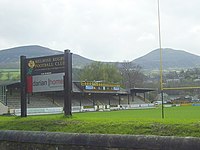History of rugby union in Scotland
As with the history of rugby union itself however, it emerged from older traditional forms of football which preceded the codification of the sport.
Scotland took part in co-hosting the 1991 Rugby World Cup, alongside the rest of the United Kingdom, Ireland and France.
It is known that unregulated forms of football were played at all of these schools, but it was in Edinburgh that the handling game first took root and spread to other areas of the country.
The first-ever inter-school match recorded in Scotland was Royal High School versus Merchiston (in Edinburgh), played on 13 February 1858.
In The High School, in the early 1860s, football was played with '...monstrous inflated globes of vast circumference and ponderosity...'.
In those early club matches play was often halted whilst captains and umpires tried to settle some point of difference.
Alas, no copy survives but it is worthy of note that neither the clubs nor The Green Book felt it necessary to include the word 'Rugby' in their title.
The first international rugby football game resulted from a challenge issued in the sporting weekly Bell's Weekly on 8 December 1870 and signed by the captains of five Scottish clubs, inviting any team "selected from the whole of England" to a 20-a-side game to be played under the Rugby rules.
[3] The game, played over two halves of 50 minutes between 20-a-side, was won by Scotland, who scored a goal (a try followed by a successful conversion kick).
The members had decided to disband: the cup was crafted from melted-down silver rupees which became available when the club's funds were withdrawn from the bank.
However, their Triple Crown win in 1907 would be the last for eighteen years as the First World War (1914–18) and England intervened to deny them glory.
70,000 spectators saw the lead change hands three times before Scotland secured a 14–11 victory which gave them their first-ever Five Nations Grand Slam.
In 1971 the SRU appointed Bill Dickinson as their head coach, after years of avoidance, as it was their belief that rugby should remain an amateur sport.
The 1983–84 season brought a draw with the All Blacks 25–25 in the late autumn and their second Grand Slam captained by Jim Aitken.
Rutherford, the team's general and controlling influence, badly injured his knee on an unauthorised tour of Bermuda.
Their greatest year in the modern era, however, was 1990 when, captained by prop David Sole, their season came down to one game, a Grand Slam decider at Murrayfield against the "auld enemy" and hot favourites, England.
Sole famously walked his men onto the field with quiet but steely determination, to the delight of the partisan home crowd.
The tournament followed a familiar pattern: a narrow defeat by France, thanks to an injury-time try, meant that, as second in the pool, they faced a quarter-final against New Zealand and were eliminated.
The SRU redeveloped Murrayfield Stadium, which is the main home ground of the Scottish national team starting 1993.
For the first two seasons, players were still released to play for their clubs in domestic competition, but eventually the districts became full-time operations.
[8] Then financial difficulties – the SRU's high debt, partly as a result of the redevelopment of Murrayfield and this initial lack of support from traditional club fans – called for retrenchment.
In 1996, the 4 newly professional Districts continued as before, playing in the Scottish Inter-District Championship which became a European Qualifying Tournament.
This meant that the Scottish Exiles side was excluded from the professional Inter-District Championship as it could not represent Scotland in European competition.
Scotland also won the last-ever Five Nations Championship in 1999 with some dashing displays of 15-man rugby and to a last minute win by Wales over England, but that year's World Cup ended the usual way, with a quarter-final defeat by New Zealand.
They endured a torrid Six Nations in 2000, losing their first four straight games including a humiliating 34–20 defeat to a debuting Italy.
In their last game they managed a 19–13 win under captain Andy Nicol over an unbeaten England at a rain-soaked Murrayfield After a poor start in the Six Nations in 2004 in which Scotland did not win a single match and claimed the wooden spoon, things were believed to be steadily improving once again under the Australian coach Matt Williams, the first foreigner to coach the national team.
Meanwhile, the Scottish Rugby Union (SRU) is under new management, Chief Executive Phil Anderton (known as 'Firework Phil' for his pre-match entertainment spectacles) was leading the way back to financial solvency and implementing major reforms to reverse the decline of the game in Scotland, but he resigned in January 2005 after his boss David Mackay was forced to resign by the SRU's general committee.
Frank Hadden, the head coach of Edinburgh Gunners (previously a PE teacher at Merchiston Castle School in Edinburgh), was appointed interim coach for the 2005 summer internationals against the Barbarians and Romania, winning two from two and instilling confidence in the national side again.
Also in the same year, the SRU began organising the Edinburgh 7s, the final event in the annual IRB Sevens World Series.
Pressure on Frank Hadden started to intensify after round 2 as Scotland lost 30–15 to a rejuvenated Wales side who could have scored more.








